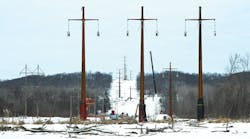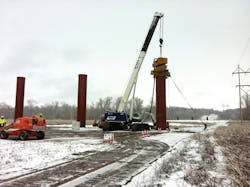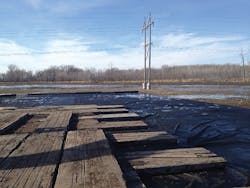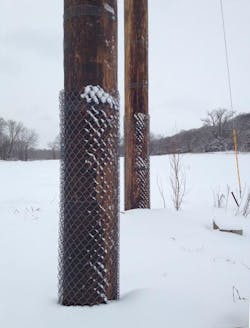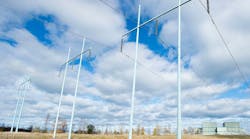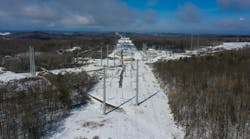A migratory flyway, delineated wetlands, deer-hunting season and spring flooding presented challenges and restrictions to a transmission line expansion project in southern Minnesota.
The CapX2020 Brookings County-Hampton project is a 248-mile (399-km), 345-kV transmission line with seven new substations and two substation expansions. The transmission line is comprised of steel monopole structures, averaging 150 ft (46 m) tall, set atop drilled pier foundations — with a few exceptions. The line crosses the Minnesota River three times, and one crossing traverses a lowland floodplain near Belle Plaine, Minnesota, where the project team was faced with a series of unique challenges.
Flying, Hunting, Thawing
Because of the high concentration of eagles in the area, which also is a migratory flyway, the project was faced with a stringent permitting process that, among other things, restricted the height of structures to about 100 ft (30.5 m) above the floodplain. This resulted in relatively short structures with correspondingly short spans, which had to be set on foundations extended above grade by about 14 ft (4.3 m) because of the spring flooding that frequently occurs in this location. The phases had to be rolled from a double-circuit vertical configuration to a horizontal configuration suspended by three separate poles.
An old hunting lodge with an existing trail provided access for project crews. The project could not improve the trail because of restrictions on importing granular fill into the delineated wetlands, so conventional wood matting was used to provide access where underlying soils were not competent to support the traffic. Because of the deer hunting season that occurs in the area each fall, and the necessity to complete construction before the spring thaw, construction was limited to between December 1 and February 28.
Good Vibrations
The Belle Plaine crossing originally included six structures. Early in the design process, the team moved one of the structures about 100 ft to the south, far enough to get it out of the floodplain and on high ground so a conventional drilled pier foundation could be constructed.
One foundation was located on the north side of the river and had no extraordinary requirements, so it was constructed as a set of three drilled pier foundations with anchor bolts. A vibratory casing was used as a construction aid in poor soils as well as a concrete form for pouring the reveal, or extended height above the floodplain.
Four structure locations were adjacent to a municipal wastewater treatment facility, and there was great concern about damaging the integrity of the clay liner because of vibrations from heavy construction equipment traffic. Given this constraint, project managers and engineers decided to use steel caissons driven directly into the marginally competent soils rather than conventional drilled pier foundations. Drilled pier foundations would have required hauling many loads of spoils, rebar and concrete next to the facility. Vibration monitors were used throughout construction to continuously monitor and record vibrations. The treatment cells were tested before construction began and again after construction was completed. The tests confirmed the clay liner remained intact and the precautions taken by the team mitigated any possible damage.
Construction, Beavers and Muck
Beginning in early December, crews began building the matting system, soon to be followed by structure installation, conductor and shield wire stringing, and removing the access mats. The 100-year flood elevation design criteria placed the top of the caissons an average of 14 ft (4.3 m) above existing grade. At one structure location, there was a pond formed by a series of beaver dams. As the team started demolishing dams, the beavers earned their reputation of being busy by replacing demolished sections overnight, to the dismay of the team.
The beavers eventually relocated, and the pond level receded to reveal a 15-ft (4.6-m)-deep layer of organics (slimy muck) that would not support a conventional wood mat. The team was concerned any conventional mats placed here would not be recoverable. Further, barges could not be used because the bottom of the pond was not level, leaving parts of the barges resting on solid ground, which the leasing company prohibited. The project team relied on lessons learned from a prior wetland crossing and called in the experts at New South Access and Environmental Solutions to provide an access solution.
New South was called on early in the planning process and developed a solution to access the site in a manner that protected the environmentally sensitive area and met the project’s strict timeline. The utilities on the project required the access system be safe, have minimal environmental impact, be competitively priced and meet the stringent time constraints the seasons provided.
New South employed its emtek Wetlands Access system and constructed a working surface that allowed the team members to do their jobs safely and efficiently, while applying minimal ground pressure and protecting the wetland. In one key area, New South found it necessary to provide a geotech fabric underlayment beneath the mat platform. This provided for a working platform that could support in excess of 500 tons (453 metric tons).
The access system did not penetrate the wetland surface, so every single mat was recovered. The New South team helped the CapX2020 project team move the project forward by providing safe access, protecting the wetland and keeping this project on schedule.
Given the many time constraints, the team put a great deal of effort into calibrating the supply chain to orchestrate just-in-time delivery of structures and caissons. Given the working crews consisted of 40 to 50 workers with heavy cranes and bucket trucks, provisions had to be made to deliver the structures and caissons without impacting the progress of the crews. A one-lane access trail compounded this logistics problem immensely, as the trail could not be improved in the wetlands.
Caisson Considerations
Four structure locations each had three separate caisson foundations. Each caisson is approximately 90 ft (27 m) long and 8 ft (2.4 m) in diameter with a 1-inch (25-mm) wall thickness. Each caisson was shipped in three pieces that were welded together. Six welders completed one weld per day. Each weld was tested and none were rejected. There was a total of just more than 300 lineal ft (91 m) of welding. Each caisson was galvanized and had a rust-preventive coating.
Additional coordination was required to install the caisson sections, weld the sections together and test them, then frame and erect the structures, which were set 14 ft in the air. The caissons were designed with a series of drilled holes, with nuts welded to the holes so bolts could be used to plumb the structures. Alas, the nuts were fouled by the galvanizing process and alternative means had to be devised on the fly. The team employed scissor-type car jacks with extended handles to operate them, as the socket was about 8 ft deep and only about 1 ft (0.3 m) wide. This enabled the structure to be set in the socket, the car jacks to center the structure in the socket rapidly and plumbing of the structure prior to pouring the grout. As the grout was poured, the jacks were pulled up because the grout only took a matter of 10 minutes or so to set up, leaving no margin for error.
Micromanagement
The river crossing area was managed as a micro project because of the construction complexity and given there was only one season to cross the river bottom because of expected flooding. The team developed a schedule that was more detailed than standard projects generally use. Daily briefings, as well as discussion during weekly look-ahead meetings, were used to track progress and prevent issues from impacting the schedule.
Because of the complex nature of this work and the many unknowns at the time of pricing the work, it was initially priced as time and equipment (T&E) with a target price to reduce risk and contingency for the bidders. As the team developed a plan, and permits and logistics were laid out, each contractor was given a chance to convert to a fixed-price lump sum bidding strategy.
The foundation contractor chose to stick with the T&E approach given limited geotechnical soil reports and the high variability in subsurface conditions. The project team felt this approach optimized the means, methods and productivity that were in the control of the contractor while leaving unknown soil conditions and adverse weather as owner’s contingency — to be spent when risk events were experienced — rather than included in the contractor’s pricing and retained as excess profit. If this would have been bid as fixed price, then it would have included a worst-case scenario to protect the bidder.
The aboveground electrical contractor ultimately felt comfortable enough with the detailed execution plan that it converted to a fixed-price bid and dropped its price accordingly as risk events were identified and mitigated.
CapX2020 Projects
The Brookings County-Hampton project is part of the CapX2020 projects, a series of more than 700 miles (1,127 km) of high-voltage transmission infrastructure serving Minnesota and the surrounding region. The three 345-kV projects and one 230-kV project will meet projected electric growth in the upper Midwest, ensure reliable service in communities throughout the region and connect to new energy sources, particularly wind energy in western Minnesota and the Dakotas.
- The 70-mile (113-km), 230-kV Bemidji-Grand Rapids project was energized in 2012.
- The 250-mile (402-km), 345-kV Brookings County-Hampton project has a projected completion of early 2015.
- The 200-mile (322-km), 345-kV Fargo-St. Cloud/Monticello project, with a 28-mile (45-km) St. Cloud-Monticello segment, was energized in late 2011 and has a projected completion of early 2015.
- The 150-mile (241-km), 345-kV Hampton-Rochester-LaCrosse project has a projected completion of late 2015.
- In 2012, CapX2020 added an additional project in South Dakota. The 70-mile Big Stone South-Brookings County 345-kV project is expected to begin construction in 2015 with an in-service date of 2017.
Originally proposed in 2007, the projects underwent significant regulatory review in each state where they are located, with construction beginning on the first project in 2010. As of early 2013, nearly 100 miles (161 km) of lines are energized, with the remaining projects expected to be completed in 2015. The first half of the Brookings County-Hampton project between Lyon County, Minnesota, and eastern Scott County, Minnesota, is scheduled to be energized in April 2014. The entire project will be placed in service by early 2015.
Mark Anderson ([email protected]) is Great River Energy’s project manager for the Brookings County-Hampton project. He has managed nearly 1,000 miles (1,609 km) of high-voltage and extra-high-voltage multi-state and multi-year transmission projects. Anderson’s experience includes working for electrical contractors as well as owners, and providing consulting services to both.
Companies mentioned:
CapX2020 | www.capx2020.com
Great River Energy | www.greatriverenergy.com
New South | www.newsouthmat.com
Sidebar: Beaver Wrap
Great River Energy, one of the CapX2020 project owners, had an older wood H-frame 69-kV line on an adjacent easement across the river bottom. The construction team reported extensive woodpecker damage to the poles and offered the use of the access matting to replace the structures. This project also was successfully undertaken during the same time frame as the Brookings County-Hampton project.
Unfortunately, beavers in the area gnawed nearly all the way through a new wood pole in just one night. So, the crews determined it was necessary to wrap the base of the structures with woven wire material normally used for substation fencing, thereby inventing a so-called “beaver wrap” to complement the woodpecker wrap used on the tops of these bottomland structures.
